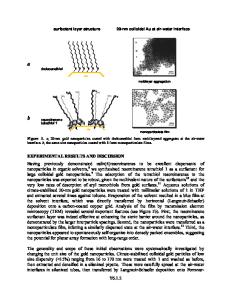Optical properties of nanostructured carbon and gold nanoparticle hybrids
- PDF / 268,569 Bytes
- 4 Pages / 432 x 648 pts Page_size
- 42 Downloads / 304 Views
Optical properties of nanostructured carbon and gold nanoparticle hybrids Yuan Li,1 Nitin Chopra,1,2,* 1 Metallurgical and Materials Engineering Department, Center for Materials for Information Technology (MINT), The University of Alabama, Tuscaloosa, AL 35487, U.S.A. 2 Department of Biological Sciences, The University of Alabama, Tuscaloosa, AL 35487, U.S.A. *Corresponding Author E mail: [email protected], Tel: 205-348-4153, Fax: 205-348-2164
ABSTRACT We report simulation of optical properties of hybrid geometry comprised of multilayer graphene shell encapsulated gold nanoparticles loaded with carbon nanotubes. The discrete dipole approximation (DDA) method was employed. The results indicated that the optical properties of encapsulated gold nanoparticles were not suppressed by the carbon material coating. Furthermore, low scattering effects were also observed. The simulation method helped visualize the near-surface normalized electric field, which is directly related to the intensity of hot spots on the surface of these hybrid nanoarchitectures. INTRODUCTION Self-assembly and chemical patterning of carbon nanotubes (CNTs) is critical for applications in nanoelectronics and sensors [1-4]. Recently, the reproducibility and sensitivity of devices based on CNTs for DNA recognition was demonstrated [5]. Complex nanoscale heterostructures based on CNTs are of particular interest to achieve greater functionality in nanodevices and sensors [6,7]. In this direction, controlled arrangement or positioning of CNTs on complex substrates is still a big challenge. Recently, the authors demonstrated a facile and scalable chemical vapor deposition (CVD) approach for the growth of multilayer graphene shells on gold (Au) nanoparticles (GNPs) [8]. The surface chemistry of multilayer graphene shell was demonstrated for applications in bioanalysis. Here, we report the basic simulation results of hetero-nano-architectures comprised of CNTs and GNPs (GNP-CNT heterostructures). The simulation was performed using discrete dipole approximation (DDA) approach. EXPERIMENT Discrete dipole approximation (DDA) method was used to simulate the optical properties of GNP-CNT heterostructures. This method is based on 3-D Maxwell equation via the DDSCAT code developed by Draine and Flatau [9,10]. Detailed simulation procedures have been demonstrated by our group in an earlier report [11]. Briefly, DDSCAT 7.2 was utilized to estimate normalized electric field intensity or surface plasmon generation for the GNP-CNT heterostructures. The normalized electric field intensity is defined as the ratio between the electric field generated near the nanostructures and the incident electric field (|E|/|E0|). The effective radius of dipoles was calculated using: Reff = (3V/4π)1/3, where V is total volume of the
79
material in the target and is calculated using V = Nd3 (N is the number of dipoles and dis the lattice spacing in cubic array). DISCUSSION Figure 1 shows the HRTEM image of GNPs fabricated in CVD process developed by the authors [8]. These as-produce
Data Loading...










